As an Amazon Associate I earn from qualifying purchases.
Everyone wants to learn how to make ceviche, and, while ceviche recipes are all over the place, a basic ceviche is, more or less, pico de gallo with fish or seafood in it.
Ceviche is one of those seemingly esoteric dishes that Americans have truly embraced, especially those of us who live fairly near the ocean. A Peruvian invention, the original ceviche recipe is fish or seafood marinated in citrus juices, which then “cook” the fish. I’ve seen all sorts of versions served in restaurants, and if you look on any angler’s forum you’ll see recipes for ceviche of… well anything, really.
This can be a very bad idea.
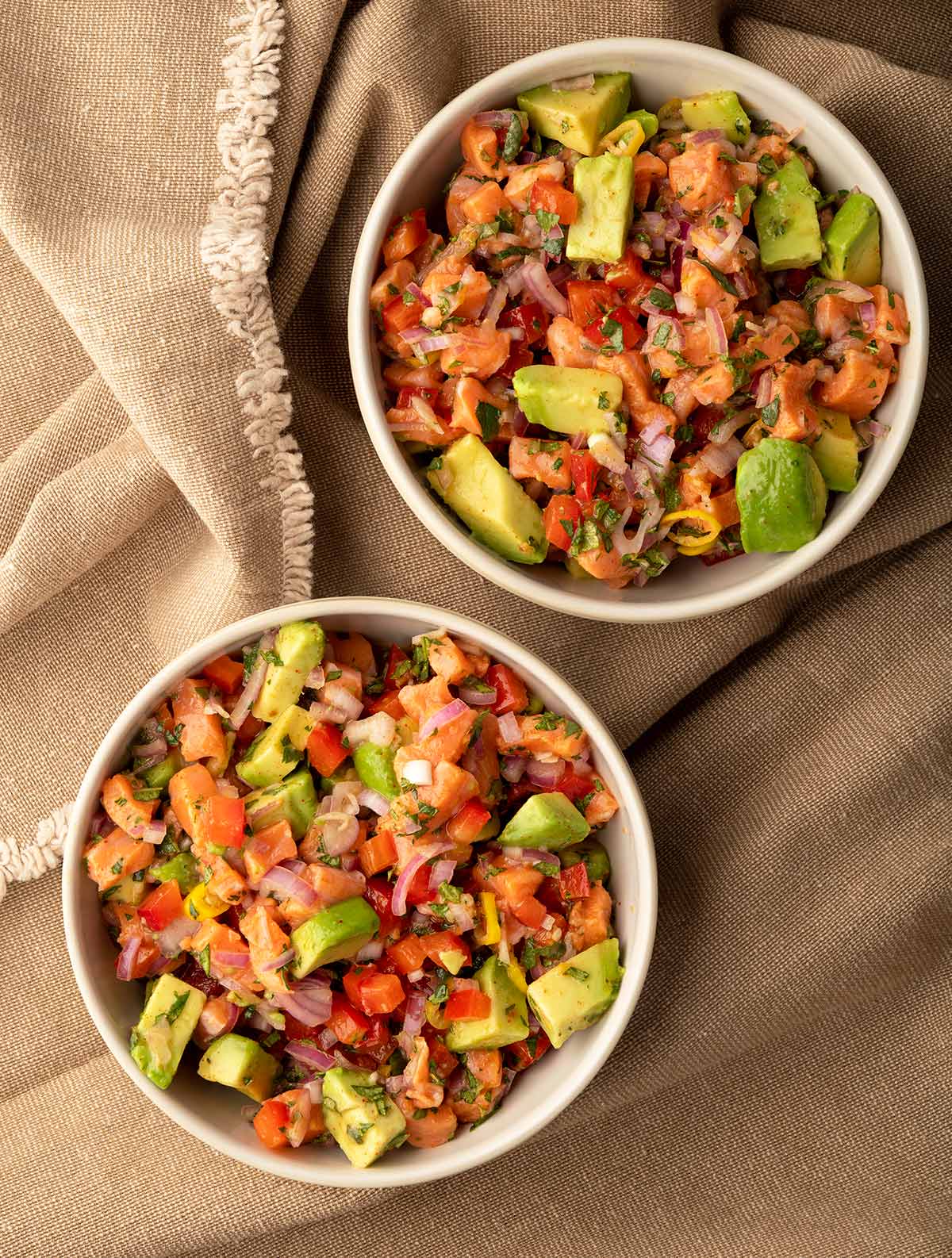
The reason is because ceviche (sev-ee-chay) is still, for the most part, a raw fish dish.
The citrus bath the fish or seafood sits in does turn the meat opaque, giving it the appearance of being cooked, and it does kill some of the many wee beasties present in raw foods that can make you sick, notably the toxin vibrio. But the ceviche-making process will not protect you from the worst of the nasties, ranging from salmonella to parasites and worms.
Certain species of fish tend to be more or less prone to parasites. So the best fish for ceviche are those you would see at a trip to the sushi bar. Tuna and other pelagic species tend to be free of parasites (swordfish being a notable exception), as is farmed salmon (oddly). But ever notice that mackerel (saba) is always cured?
That’s because it can often contain anasakis worm larvae, also known as seal worm. Everything in the cod family is especially prone to infestation, too, which is why you never see cod sushi.
Here in the West, Pacific salmon, rockfish and halibut well known to harbor anasakis larvae, and to be safe you must freeze your fish before eating it raw. And when I mean freezing I mean really freezing. You need the fish to hit -4°F for about a week to do the trick. Note that older home freezers never hit this temperature.
(If you want to learn more on this topic, we did an entire podcast episode on parasites in fish.)
I don’t want to scare you too much. The vast majority of illnesses you might get from eating tainted or parasite-laden raw fish will be moderate to light. It’ll feel like food poisoning, with cramps, nausea and a serious case of the trots. Not fun, but not life-threatening, either. This is because in most cases we are not what’s called a “definitive” host, meaning the parasite hits a dead end with us.
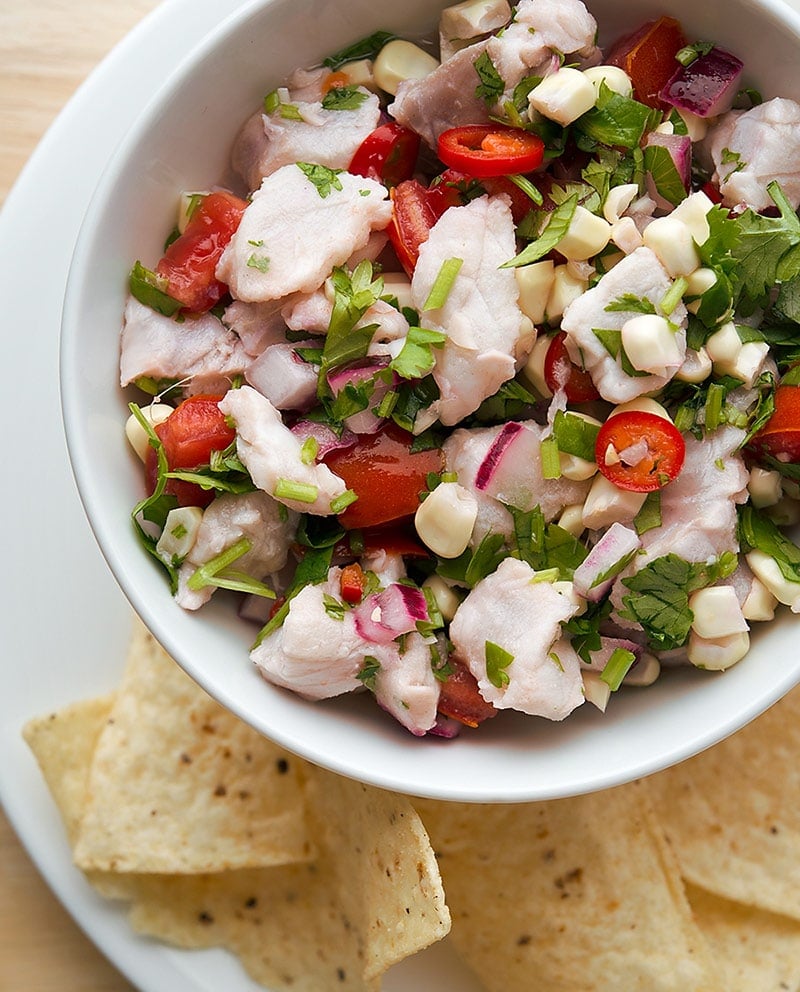
Seal worm is a great example. The seal worm (anasakis) is around wherever there are seals and sea lions — they are the “definitive” host for that parasite. When we eat raw, tainted salmon, the worm says, “Cool! A mammal! Let’s attach to his intestines.” But the worm soon learns that a person is not a sea lion and it dies, but not before making you sick.
We are a definitive host to lovely critters like liver flukes and tapeworm, however, which are common in North American freshwater fish. The single largest vector for tapeworm in America is from people eating raw or undercooked trout. People think, “Hey! I love salmon sushi, and trout is just a cousin of a salmon, so…”
Bad idea. Under no circumstances should you eat freshwater fish raw or in ceviche that has not been properly frozen first. Remember the only way to get rid of a tapeworm, which can grow longer than 20 feet in your guts (nasty!) — is to take medicine that will kill it. You then need to eject the thing. Ew.
Now that I’ve freaked you all out, here’s some good news: Actual illness from parasites and such is pretty rare. I’ve known guys who’ve eaten fresh raw salmon for years without getting sick, and raw Pacific salmon is one of the fish with the highest incidence of tapeworm and seal worm infestation.
What’s more, you can vastly improve your chances of avoiding parasites in your fish by killing the fish quickly when it comes overboard, bleeding it, and gutting it ASAP. This last bit is the most important because virtually all the parasites hang out in the viscera of fish, not the meat. In most cases, the meat gets tainted because when the fish dies the parasites panic and burrow into the meat.
Here is an overview of seafood safety from the Centers for Disease Control and Prevention.
Bottom Line: Unless you are tuna fishing, make your ceviche from pre-frozen fish. It’s just a smart thing to do.
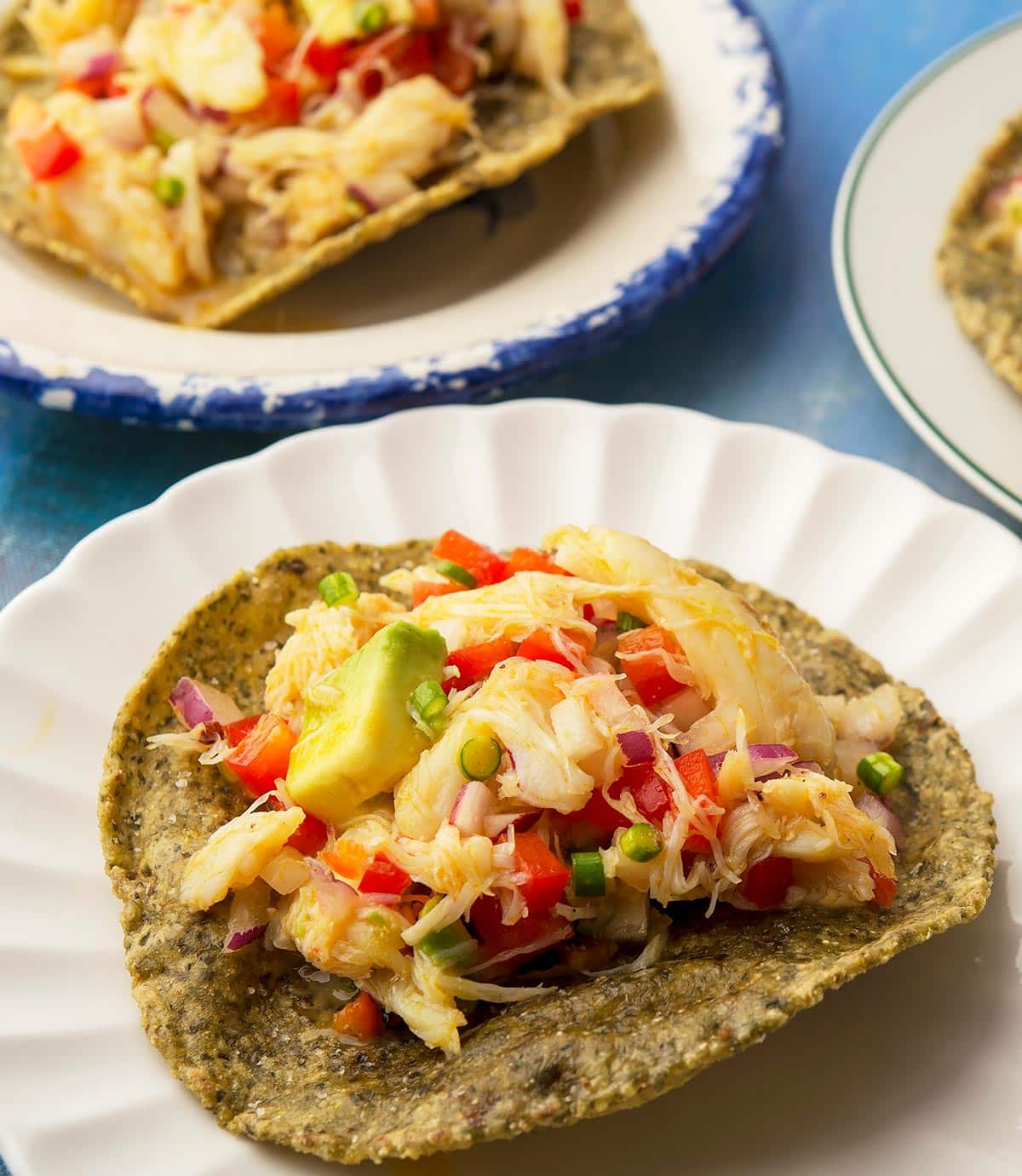
Once it’s been properly frozen, however, the sky’s the limit. A traditional Peruvian ceviche recipe typically has onions, chiles, cilantro and sometimes corn and tomatoes. I normally go that route and serve an appetizer-style ceviche that’s great eaten on tortilla chips. Fantastic for a light dinner, or to put out when you are watching football or having a party.
I have variations on how to make ceviche that range all over the Latin American world, from a Chilean salmon ceviche, to Mexican crab ceviche tostadas, and even a ceviche de calamar, with squid.
Marinating times make a difference when you are making ceviche. Depending on the size of the fish pieces, you will need at least 30 minutes and normally an hour for the citrus to “cook” the fish. Two hours is fine, but beyond that the ceviche, while still good, becomes more of a pickled fish thing. It’s a subtle difference, but you can taste it.
If you don’t marinate the fish at all, and serve basically a mash-up of sushi and ceviche, you have Mexican aguachile.
Citrus matters, too. You always want the dominant citrus in the marinade to be either limes or lemons, which are far more acidic than oranges, grapefruits or tangerines. Add these fruits as an accent to the ceviche; I am especially fond of a little grapefruit in the mix.
Basic Ceviche
Ingredients
- 1 pound pre-frozen lingcod, rockfish or other lean, white fish
- 3 limes
- 2 lemons
- 1 grapefruit
- Salt and black pepper
- 1/2 red onion, sliced root to tip
- 2 Roma or other paste tomatoes, seeded
- 1 ear of corn, kernels sliced off
- 1 habanero or rocoto chile pepper, or more to taste
- 3 tablespoons chopped cilantro
Instructions
- Slice the fish into small, bite-sized pieces. Cut the tomatoes into pieces the same size as the fish and set them aside for later. Zest 1 lime, 1 lemon and the grapefruit and grate them fine; I use a microplane grater to do this. Mince the habanero fine. Juice all the citrus. Add all the ingredients except for the tomatoes and the cilantro to a bowl or plastic container with a lid and refrigerate for 30 minutes to 2 hours.
- Add the tomatoes and cilantro, mix well and serve cold with chips.
Video
Nutrition
Nutrition information is automatically calculated, so should only be used as an approximation.

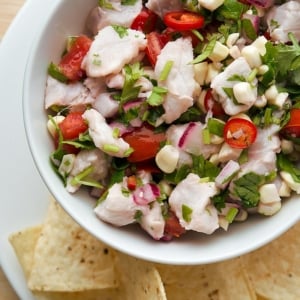
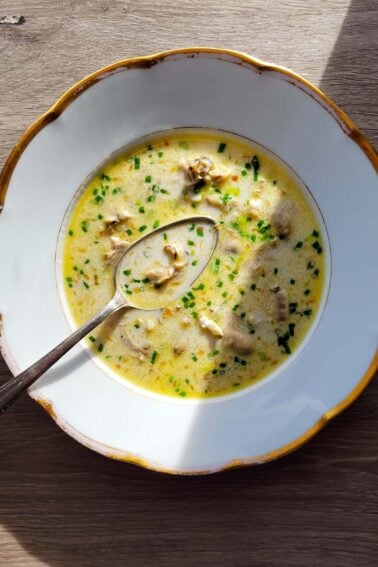

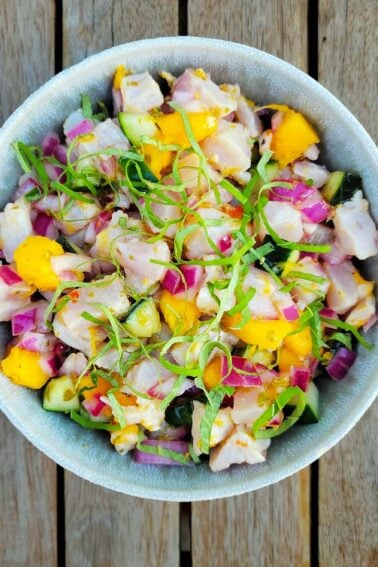
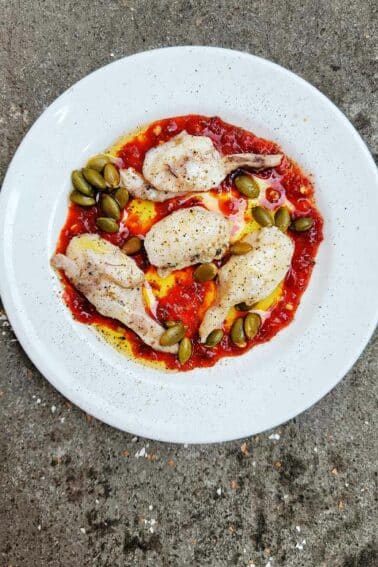
Got this at Trader Joe’s…the package says wild caught, cod filets previously frozen. But after seeing your link, I put it in my freezer again, thinking that might help. I think I should just forget the ceviche made with cod and go buy another whitefish. I do not eat talapia so what frozen fish do you recommend? Would shrimp be ok, as I’ve seen some recipes using that. Thanks for your reply.
Jacy: Shrimp is a good choice, as would be seabass, yellowfin tuna, yellowtail or snapper.
Just Bought some fresh cod and actually in the process of making my ceviche to have later today. Do I need to freeze the cod overnight and start over tomorrow? I found this link while looking for ceviche recipes. Thanks !!!
Jacy: By “cod,” do you mean actual codfish? Or lingcod? Or rock cod? No one I know of makes ceviche from actual codfish, as they tend to be wormy.
I question if freezing actual kills the parasites, maybe also depends the stage of life cycle of parasite also. I seen frozen black cod with live worms after it was thawed. Probably marine fish would not be a threat to humans since they are specific to the host occupation.
I was curious in the effectiveness of poaching cod briefly before making a ceviche. I poached some Lingcod for approximately five minutes before flaking and marinating it in the lime juice. Ive done it once before and was fine but am suddenly a little unsure. Do you think this method would be or is effective? Thank you!
E. Guzman: I bet that would work, so long as the meat is cooked to the center.
Raw frozen shrimp,3tomatoes seeded and chopped, 1/2 red onion chopped, 3stalks celery,2 cucumbers seeded and peeled,2 jalapeno seeded and chopped, 5 lemons and 5 limes juiced, 2 cups clamato,2 cups spicy v8. Marinate shrimp for 1 hour in lemon and lime juice,mix all other ingredients in large bowl and add shrimp and juices…salt and pepper to taste………..this is an awesome ceviche..friends that say they don’t eat raw fish…well I just say its shrimp cocktail.
With ciguatera poisoning, it doesn’t matter if the fish is cured, frozen or cooked into oblivion. The toxin that causes it still remains and does nasty things. It bio accumulates, so bigger predatory tropical “reef” fish are more likely to contain the toxin. It’s still very rare.
I didn’t find out about it until after a trip to the Yucatán and consuming half a barracuda, one of the higher risk fish. It’s scary, but unless you’re going to swear off grouper, snapper, amberjack, and barracuda, it’s a risk many are willing to take.
I don’t usually buy frozen fish — I just don’t care for its texture after cooking (always seems a little watery). But we love ceviche, so it sounds like I should watch for some on sale?
I do buy frozen shrimp all the time (lean, quick-cooking protein) — do the recommendations about freezing hold for those too? Or is that one I should get live off the boats? What about bay scallops — commercially frozen the way to go??
(my home freezer probably not up to the task)
I’ve eaten snapper ceviche roughly an hour after the fish was pulled from the water…obviously it didn’t kill me or any of the other souls on the boat that ate it, but is this a bad idea? Always out of the Gulf of Mexico.
Hard to say. A lot less parasites that can hurt you in warm seawater, but when it gets too warm you get into cigatura poisoning, which you see a lot with barracuda. Like I said in a previous comment, I’ve done it, and will continue to do so on occasion — but if I were catering or serving to the young or old or a dinner party, I’d freeze the fish first to be safe.
Wish I would have read this post before making last night’s crappie ceviche. Although it was frozen for days inside a block of ice I won’t do that again. Thanks for the information as always Hank!
Thoughts on pickling trout in vinegar? My recipe calls for 2 weeks in the fridge before eating. Will the vinegar for that amount of time kill the worms?
What about curing fish–e.g. gravlax?
I assume the curing process *doesn’t* do the number you want it to on the parasites, but…
I’ve been worried about parasites for a few years–and have all but stopped making gravlax with anything but frozen salmon. And that, really, seems a shame, here in the Bay Area.
Yep. Gravlax won’t kill most parasites. Sorry!
Ceviche is one of my husband’s fav treats, but we don’t make it at home.
This sort of thing is best left to the pros, especially like you said, home freezers don’t reach temps low enough to really kill any of those nasty bugs!
Hank –
Ever try it with Striped Bass? Do you recommend?
Yep. I like striper ceviche!
Ah good old Enterovioform! I’d forgotten that name of what was sort of the golden remedy for things like amoebic dysentery – and killed all the beneficial biota in the intestinal tract.
Great recipe and great information about possible pitfalls. Friends have made a good one using tilapia which now I hope that been well frozen first. If not, we got away lucky. I am partial to shrimp ceviche, which I have made quite a bit.
And finally you and I have disagreed on another possible addition which the Incas apparently never used, and that is including avocado. A local taqueria adds several slices on top of its ceviche tostado. It is a pleasant bland foil to the sharp acidity of the dish. Try it.
Down Under way we make variations like kokoda in Fiji and poisson cru in Tahiti. I know how sick people can become from such as many moons ago and as young medical student armed only with a huge bottle of enterovioform then used [we were en route to feared Mexico!] I had to treat a whole large hotel outside of Papeete and outside medical care as the resident doctor was too drunk after a merry Saturday buffet lunch . . . Some 200 souls and I feared we would lose a few . . .
So you think that commercially frozen fish is adequately frozen for time and temperature both? Thanks.
Yes.
When you recommend “pre-frozen” fish, and also go on to say that many home freezers do not reach the required temperature, then do you mean commercially frozen fish? Thanks.
Yep. But check your freezer: It may very well go down to -4 degrees. A lot of new ones do.
In terms of freshwater fish, would crappie be safe for this recipe? I’m curious why you don’t recommend freshwater fish.
There are just too many parasites going on in freshwater fish that really do well once inside a human GI tract. Most marine parasites don’t accept the human innards, resulting in at worst a case of the shits. Freshwater tapeworm and liver flukes are far nastier. But still, I bet if you froze the hell out of the crappie it’d be OK.
Thanks Hank. I really enjoy the educational side of your postings. While I’ve hunted and fished many long years I continually learn from your writings.
Mine is more of a mixed seafood ceviche and uses 1/3 Snapper, 1/3 Bay Scallops and 1/3 Shrimp. Oh and I also use sweet onion in mine, either Vidalia or Texas 1015; about 1/4 large onion per lb of seafood. But like you said, recipes vary and go with what you enjoy.